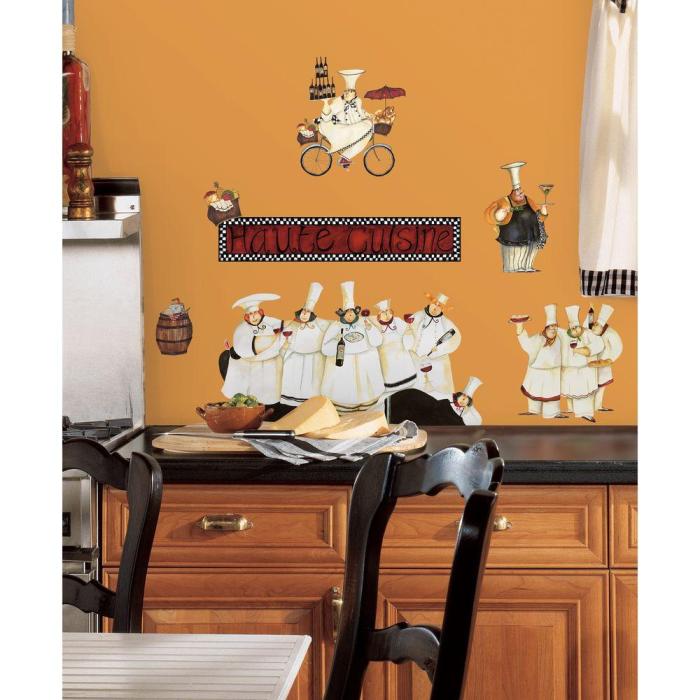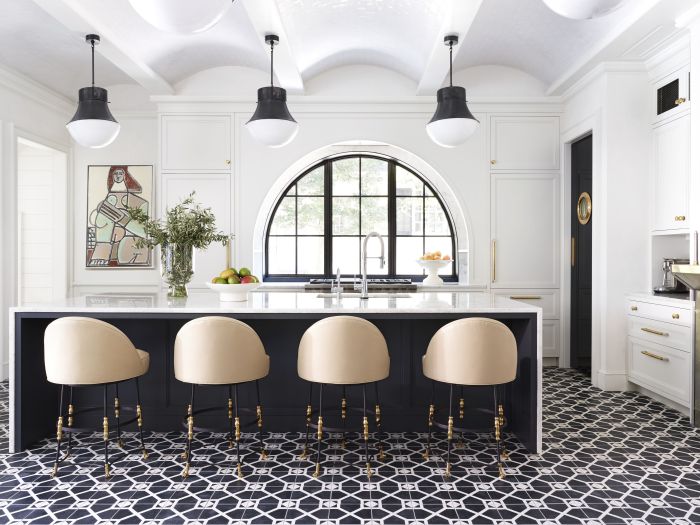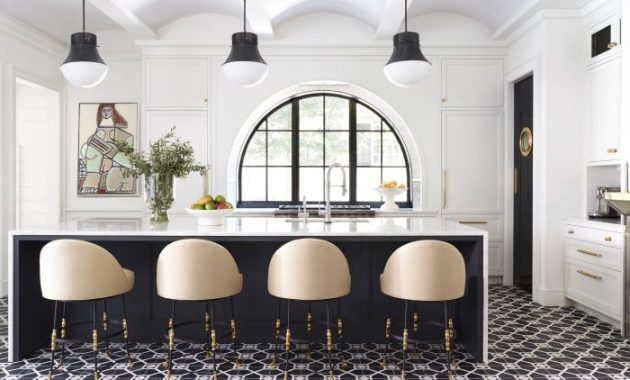Bistro Chef Kitchen Aesthetics
Bistro chef kitchen decor – The heart of a successful bistro lies not just in the food, but in the environment where it’s created. A bistro chef’s kitchen is a fascinating blend of controlled chaos and meticulous design, where functionality and style must coexist seamlessly. It’s a space that reflects the chef’s personality and culinary philosophy, creating an atmosphere that inspires both the culinary team and, indirectly, the diners who enjoy the fruits of their labor.
Overall Ambiance of a Bistro Chef’s Kitchen
The ambiance of a bistro chef’s kitchen is one of purposeful energy. It’s a dynamic space, characterized by a sense of controlled movement and focused activity. While efficiency is paramount, the design should avoid feeling sterile or impersonal. Instead, it aims for a warm, inviting atmosphere that fosters teamwork and creativity. Think polished stainless steel gleaming under strategically placed lighting, the rich aroma of herbs and spices mingling with the subtle scent of freshly baked bread, and the rhythmic clatter of pans and knives a constant, comforting soundtrack.
The design prioritizes clear workflows, easy access to essential tools, and a comfortable environment for the kitchen staff to work long hours. The overall feel should be one of professional competence and quiet confidence.
Lighting in a Bistro Kitchen
Lighting plays a crucial role in establishing the right mood and ensuring optimal functionality. The bistro kitchen needs a layered approach, combining ambient, task, and accent lighting. Ambient lighting, perhaps from recessed fixtures or pendant lights, provides a general illumination, creating a welcoming atmosphere. Task lighting, such as under-cabinet lights or strategically placed spotlights, is essential above work areas like prep stations and ranges, ensuring clear visibility for precise food preparation.
Accent lighting, using warmer-toned spotlights, can highlight key architectural features or display collections of copper pots or vintage kitchen tools, adding character and visual interest to the space. The overall effect should be bright yet warm, avoiding harsh shadows that can hinder efficiency and create a less inviting atmosphere.
Color Palette for a Bistro Chef’s Kitchen
A sophisticated and efficient bistro chef’s kitchen color palette could revolve around warm neutrals with pops of accent colors. A base of creamy whites or warm grays on the walls provides a clean, spacious feel, while darker tones of wood cabinetry, such as walnut or cherry, add warmth and depth. Stainless steel appliances and countertops contribute a modern, clean aesthetic.
Accent colors could be introduced through colorful tiles on a backsplash, perhaps in shades of terracotta, deep blues, or vibrant greens, echoing the fresh ingredients used in the bistro’s cuisine. These accents should be used sparingly, to avoid overwhelming the space and maintaining a sense of calm efficiency.
Mood Board: Textures and Materials
The texture and materials selected for a bistro chef’s kitchen are key to creating a mood of both rustic charm and modern functionality. Imagine a mood board featuring the warm, inviting texture of reclaimed wood for shelving and cabinetry, contrasted with the sleek, cool surface of stainless steel countertops and appliances. The earthy tones and natural variations of a stone backsplash, perhaps a tumbled marble or slate, would add a touch of sophistication and durability.
Bistro chef kitchen decor? Think rustic charm meets culinary cool. Need some inspiration to elevate your own chef’s domain? Then check out these amazing chef kitchen decor ideas for a serious dose of kitchen envy. After all, a well-decorated kitchen is a happy kitchen, especially for a bistro chef who wants to impress with style as well as substance.
Copper accents, in the form of cookware or lighting fixtures, would introduce a touch of vintage charm and warmth. Finally, the inclusion of woven textiles, such as linen towels or cotton placemats, adds a layer of softness and tactility, grounding the space and suggesting a sense of comfortable, well-worn familiarity. The overall effect is a sophisticated yet inviting space that feels both efficient and aesthetically pleasing.
Key Design Elements: Bistro Chef Kitchen Decor

The aesthetic of a bistro chef’s kitchen hinges on a delicate balance between functionality, visual appeal, and the evocation of a warm, inviting atmosphere. It’s a space where culinary artistry meets comfortable design, creating a setting both efficient for the chef and pleasing to the eye. This balance is achieved through a careful selection of key design elements.
Three essential elements define this aesthetic: the strategic use of materials, the thoughtful integration of storage solutions, and the incorporation of carefully chosen decorative accents. Each element contributes significantly to the overall feel and functionality of the space, shaping the chef’s experience and the overall ambiance.
Material Selection in Bistro Chef Kitchens, Bistro chef kitchen decor
The choice of materials significantly impacts the bistro chef’s kitchen aesthetic. Warm, natural materials like reclaimed wood, aged metals, and natural stone countertops are favored for their rustic charm and ability to create a welcoming environment. These materials often tell a story, hinting at the history and authenticity of the bistro’s culinary heritage. In contrast, sleek stainless steel appliances and polished concrete flooring can add a touch of modern sophistication, creating a counterpoint to the rustic elements.
The juxtaposition of these contrasting materials adds depth and visual interest. For instance, a rustic wooden island topped with a sleek stainless steel prep sink and surrounded by aged metal bar stools can create a visually stunning and functional centerpiece.
Open Shelving Versus Closed Cabinetry
The decision between open shelving and closed cabinetry is a crucial design choice. Open shelving, often showcasing a curated collection of cookware, crockery, and pantry staples, adds a sense of openness and allows for easy access to frequently used items. This creates a visually appealing display, emphasizing the chef’s culinary tools and ingredients. However, it requires meticulous organization to avoid a cluttered look.
Closed cabinetry, on the other hand, provides ample storage while maintaining a clean, uncluttered appearance. It’s particularly useful for hiding less aesthetically pleasing items or maintaining a more streamlined aesthetic. A successful bistro chef’s kitchen often incorporates a blend of both, strategically using open shelving to highlight key items while utilizing closed cabinetry for storage of less visually appealing items.
The balance between the two is key to achieving a functional and visually appealing design.
The Role of Decorative Elements
Decorative elements play a vital role in enhancing the bistro chef’s kitchen aesthetic. Strategically placed artwork, such as vintage posters or culinary-themed prints, can add personality and visual interest. Potted herbs and other plants not only add a touch of greenery but also contribute to the overall sense of freshness and vibrancy. Other decorative elements could include antique copper pots hanging from the ceiling, rustic wooden cutting boards displayed on open shelving, or even a collection of vintage cookbooks.
These elements should be carefully selected to complement the overall style and avoid overwhelming the space. The goal is to create a space that feels both functional and inviting, a reflection of the chef’s personality and culinary style.
Essential Appliances for a Bistro Chef’s Kitchen
A visually appealing and functional bistro chef’s kitchen requires a selection of essential appliances. The following table Artikels five must-have appliances:
| Appliance | Description | Visual Appeal | Functionality |
|---|---|---|---|
| Range with a Pot Filler | A professional-style range with a pot filler faucet mounted above it provides both style and convenience. | Sleek and modern, often featuring stainless steel or cast iron. | Offers powerful burners and ample oven space for diverse cooking needs. The pot filler eliminates the need to carry heavy pots from the sink. |
| High-Performance Hood | A powerful and stylish hood effectively removes cooking fumes and odors while adding to the kitchen’s aesthetic. | Can be chosen to match the range or serve as a focal point with unique design features. | Essential for maintaining air quality and preventing smoke buildup. |
| Built-in Refrigerator | A built-in refrigerator seamlessly integrates into the cabinetry, maintaining a clean and uncluttered look. | Offers a streamlined aesthetic and can be customized to match the cabinetry. | Provides ample storage for ingredients and beverages. |
| Commercial-Grade Mixer | A powerful stand mixer is a versatile tool for various baking and culinary tasks. | Many models feature classic designs and vibrant colors that can add character to the kitchen. | Provides efficient mixing and kneading for various recipes. |
| Espresso Machine | A high-quality espresso machine is perfect for creating specialty coffee drinks for both the chef and guests. | Can be chosen to match the overall aesthetic of the kitchen, from sleek and modern to vintage-inspired. | Offers a convenient way to create delicious espresso-based drinks. |
Unique Bistro Kitchen Styles

The heart of any bistro, the kitchen is where culinary magic happens. But the style of that kitchen can profoundly impact the overall atmosphere and dining experience. From the rustic charm of a countryside inn to the sleek modernity of a city hotspot, the design choices tell a story. Let’s delve into three distinct styles, examining their defining features and how they create unique culinary environments.
Rustic Bistro Kitchen Style
The rustic bistro kitchen evokes a sense of warmth, history, and handcrafted charm. Imagine exposed wooden beams, aged brick walls, and a large, farmhouse-style sink. The overall feel is one of comfortable, lived-in elegance, suggesting a long tradition of culinary excellence. Think of a cozy French countryside kitchen, where generations of cooks have perfected their recipes. Natural materials are key: reclaimed wood, stone countertops, and wrought-iron accents create a sense of authenticity.
The color palette is typically warm and earthy, featuring muted greens, browns, and creams. A large, antique-style range is often the centerpiece, hinting at hearty, traditional dishes.
Modern Bistro Kitchen Style
In stark contrast to the rustic style, the modern bistro kitchen embraces sleek lines, minimalist aesthetics, and high-tech appliances. Stainless steel, glass, and polished concrete are prominent materials, creating a clean, sophisticated space. The focus is on functionality and efficiency, with streamlined cabinetry and state-of-the-art equipment. Color palettes tend towards neutral tones, with pops of bright color used sparingly as accents.
Lighting plays a crucial role, with strategically placed spotlights highlighting key features and creating a dramatic ambiance. This style speaks to a contemporary approach to culinary arts, emphasizing precision and innovation.
Industrial Bistro Kitchen Style
The industrial bistro kitchen blends rustic elements with a modern, factory-inspired aesthetic. Think exposed brick walls, metal piping, and reclaimed wood countertops. The overall feel is raw, edgy, and yet surprisingly warm. This style often incorporates vintage industrial fixtures, such as pendant lights and metal shelving, creating a unique blend of old and new. The color palette usually features metallic accents, along with darker shades of gray and brown.
This style suggests a bold, experimental approach to cooking, where tradition meets innovation in a dynamic setting.
French Bistro Kitchen Style Characteristics
A true French bistro kitchen is more than just a style; it’s a reflection of French culinary culture. It evokes the feeling of a bustling Parisian kitchen, characterized by its practicality and timeless elegance. Key elements include a focus on functionality, using durable materials that can withstand heavy use. Think of a well-worn butcher block countertop, showcasing the marks of countless meals prepared.
The color palette typically incorporates warm, earthy tones – creams, browns, and muted greens – often complemented by pops of color from fresh produce. Open shelving displays classic cookware and essential ingredients, contributing to the kitchen’s lived-in charm. A classic French range, perhaps even a wood-fired oven, is often the centerpiece, a testament to the kitchen’s culinary heart.
Countertop Material Influence on Bistro Kitchen Style
The choice of countertop material significantly impacts the overall style of a bistro kitchen. A butcher block countertop, for instance, lends itself perfectly to the rustic and industrial styles, adding a sense of warmth and practicality. Its natural variations in color and texture tell a story of use and age. Granite, with its sleek surface and wide array of colors, can enhance both modern and industrial styles, providing a durable and sophisticated look.
Marble, on the other hand, exudes elegance and sophistication, ideal for a more refined, modern bistro aesthetic. Its cool, smooth surface creates a sense of calm and luxury.
Texture’s Role in Bistro Kitchen Atmosphere
Texture plays a pivotal role in creating a unique bistro kitchen atmosphere. The rough texture of exposed brick walls, combined with the smooth surface of a granite countertop, creates a dynamic interplay of contrasts. The worn patina of a wooden table adds character and warmth, while the sleekness of stainless steel appliances provides a modern counterpoint. This carefully considered balance of textures creates a rich, multi-layered environment that engages the senses and enhances the overall dining experience.
The interplay between smooth and rough, worn and new, contributes to the story the kitchen tells, reflecting the blend of tradition and innovation that defines the bistro spirit.
FAQ Corner
What are some budget-friendly ways to achieve a bistro chef kitchen look?
Focus on affordable materials like reclaimed wood, repurposed metal, and thrifted décor. Prioritize one or two key statement pieces and build around them with more economical choices. DIY projects, such as painting cabinets or creating custom shelving, can significantly reduce costs.
How can I incorporate sustainable practices into my bistro chef kitchen design?
Choose sustainable materials like bamboo or reclaimed wood for countertops and cabinetry. Opt for energy-efficient appliances and LED lighting. Incorporate plants to improve air quality and create a calming atmosphere.
Where can I find inspiration for bistro chef kitchen designs?
Browse design magazines, online platforms like Pinterest and Houzz, and visit local restaurants with bistro-style kitchens. Pay attention to details like lighting, color palettes, and material choices to find ideas that resonate with your style.

